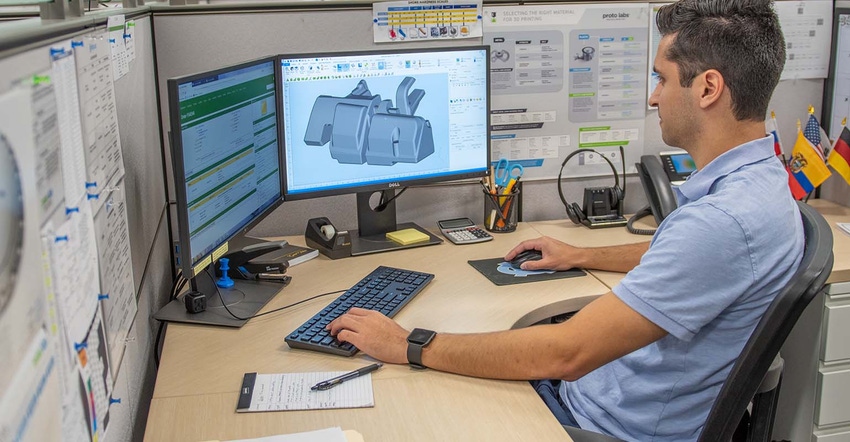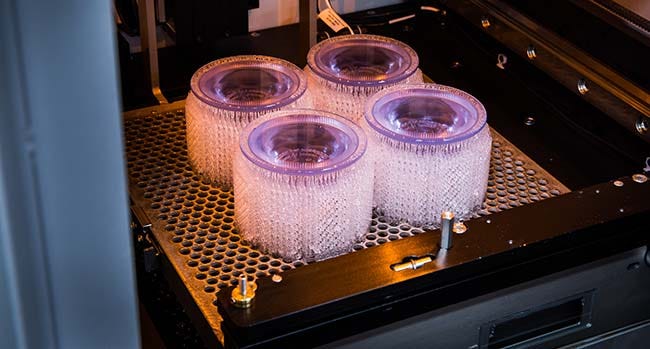Six Essential 3D-Printing Design Tips
Follow these must-know principles when designing for additive manufacturing to help ensure trouble-free production.
March 27, 2023

Joe Cretella
Additive manufacturing (AM), aka 3D printing, has evolved at a pace rarely seen in the manufacturing world. More material options and new secondary processes have expanded applications for 3D printing, while Industry 4.0–driven innovations have increased accessibility by making it easier than ever to design for additive manufacturing (DfAM). Printers, too, have improved substantially, with larger build volumes and greater precision.
Leveraging the technology still requires special considerations to which even the most seasoned product designers need to adjust. At Protolabs, we work with more than 50,000 product developers and engineers annually. Here are the top DfAM tips we communicate to customers to help ensure smooth sailing once a part hits the printer.
1. High resolution isn’t just for photos
This is probably the easiest hurdle to clear: A low-resolution STL file will affect the build of your part. The part will still be manufacturable, but there could be aesthetic effects, primarily in the form of coarse faceting where your part ends up resembling the surface of a gemstone.
We recommend choosing STP/STEP or high-resolution STL files that are still small enough to be uploaded and easily manipulated. Also, note that reducing angle tolerance often has the greatest effect when it comes to improving resolution.
2. Get to know your 3D-printing process
There are multiple 3D-printing processes, and each comes with advantages and special considerations to evaluate before you commit.
For example, stereolithography (SLA) provides industry-leading feature resolutions. However, it also has limitations in smaller holes and internal channels. If these features are too narrow, they could close while printing. The thinnest features also must be confined to the draw plane, as opposed to the build plane.
|
Stereolithography-based 3D printing achieves industry-leading resolution but has limitations when it comes to small or narrow features. |
Meanwhile, selective laser sintering (SLS) and Multi Jet Fusion (MJF) come with their own limitations, especially when working with nylons. Common issues that need to be addressed before printing include maintaining a minimum wall thickness; having the appropriate distance between features like blind holes or threads; and, whenever possible, avoiding very thin features.
The technological evolution of DfAM is especially useful in meeting these requirements. For example, Protolabs utilizes automated manufacturability analysis, which lets us instantly identify common issues on the front end, saving you time and money before the part hits the printer.
3. Keep an eye on shrinkage
Avoiding shrinkage is especially important with plastic materials when using SLS or MJF. If your parts don’t have reasonably equal distribution of material, they can be affected by inconsistent cooling. A thick end of a part will cool slowly compared to a thinner end, leading to unfortunate part shrink. Could the thick end be hollowed out? That’s one consideration to make when necessary.
4. Prevent warpage
When using powder-based printing processes like SLS and MJF, heat is used to sinter powder together into a solid part. That heat can also warp your parts if you ignore special design considerations around part thickness and size. Glass-filled nylons offer additional strength to help avoid warpage, or you can consider alternative printing options (like SLS or MJF), especially if printing parts larger than 7 in. (177.8 mm). The tried-and-true prevention tactic is maintaining uniform thickness whenever possible.
5. Consider the end game
Are you using 3D printing to prototype a part that will eventually be overmolded via injection molding? Try PolyJet. This AM technology uses a sprayable liquid photopolymer that allows you to adjust hardness as the part is built. This unique feature allows you to prototype a product that has a soft, grippable handle or gasketed cover, for example.
Overall, when considering 3D printing to prototype a part that will eventually move to injection molding for production runs, it is vital to ensure the part is moldable. Geometries that fly in the 3D printing world may not be possible with injection molding.
6. Material limitations differ with 3D printing
One example here is SLA. The printing process uses thermoplastic-like materials that do their best to mimic popular, stronger materials like ABS, polycarbonate, and polypropylene. Use of the like modifier in this case means SLA materials are great for form-and-fit prototyping but are not as strong or durable as a molded thermoplastic.
By taking time on the front end to fully consider the opportunities and limitations with 3D printing, you can more easily harness the technology to transform product development from prototyping to production.
About the author
Joe Cretella is 3D-printing applications engineering manager at Protolabs, a digital manufacturer offering injection molding, 3D printing, CNC machining, and sheet metal fabrication from prototyping to production.
You May Also Like



